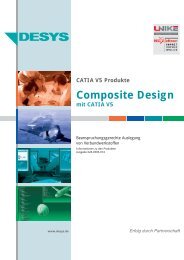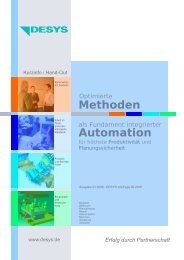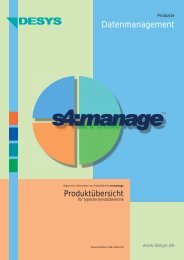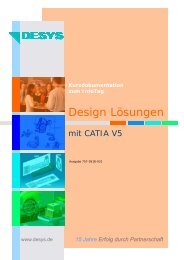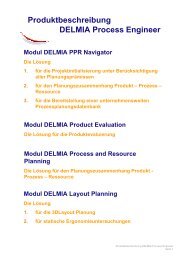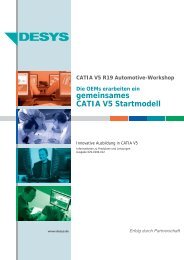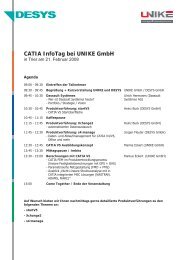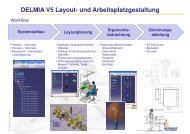CATIA 3D Functional Tolerancing & Annotation 2 (FTA) - DESYS
CATIA 3D Functional Tolerancing & Annotation 2 (FTA) - DESYS
CATIA 3D Functional Tolerancing & Annotation 2 (FTA) - DESYS
You also want an ePaper? Increase the reach of your titles
YUMPU automatically turns print PDFs into web optimized ePapers that Google loves.
<strong>CATIA</strong> V5 / <strong>3D</strong>-Master: Produkt-Overview<br />
<strong>CATIA</strong> <strong>3D</strong> <strong>Functional</strong> <strong>Tolerancing</strong> &<br />
<strong>Annotation</strong> 2 (<strong>FTA</strong>)<br />
<strong>CATIA</strong> <strong>3D</strong> <strong>Functional</strong> <strong>Tolerancing</strong> and <strong>Annotation</strong> 2<br />
(<strong>FTA</strong>) is a new-generation <strong>CATIA</strong> product that addresses<br />
the easy definition and management of<br />
tolerance specifications and annotations of <strong>3D</strong><br />
parts and products.<br />
The intuitive interface of <strong>CATIA</strong> <strong>3D</strong> <strong>Functional</strong> <strong>Tolerancing</strong><br />
and <strong>Annotation</strong> 2 product provides an<br />
ideal solution for new <strong>CATIA</strong> customers in small<br />
and medium size industries, reduces reliance on<br />
2D drawings and increases the use of <strong>3D</strong> as the<br />
master representation. <strong>3D</strong> annotations can be extracted,<br />
using the annotation plane concept in CA-<br />
TIA Generative Drafting products. Syntactic and<br />
semantic verification command allows you to check<br />
the correctness of all the annotations of the active<br />
product or part regarding to the standard used.<br />
Finally, the <strong>3D</strong> annotations can be reviewed using<br />
ENOVIA DMU Dimensioning & <strong>Tolerancing</strong> Review 1<br />
product (DT1) or DELMIA DMU Dimensioning and<br />
<strong>Tolerancing</strong> Review 2 product (MTR), which offers<br />
comprehensive tools for interpretation of annotations<br />
and tolerances on specific areas of the design<br />
or across the complete digital mockup.<br />
Features<br />
� <strong>3D</strong> Dimensioning in part, product and process<br />
documents<br />
� Provides a comprehensive set of associative annotations,<br />
texts, flag-notes and dress-up features<br />
in <strong>3D</strong> format<br />
� Display of the annotations in the <strong>3D</strong> environment<br />
using annotations planes<br />
� Allows visualization of the annotations in other<br />
workbench<br />
� <strong>Tolerancing</strong> and <strong>Annotation</strong>s associative to the<br />
<strong>3D</strong> part and product<br />
Key customer benefits<br />
Allows easy creation of associative <strong>3D</strong> tolerance<br />
specifications and annotations By creating<br />
associative <strong>3D</strong> tolerance specifications in part<br />
and product documents you can avoid reliance on<br />
2D drawings. He can apply tolerances to parts and<br />
products in the context of the assembly, using the<br />
types of tolerance that are provided Text, Datum,<br />
Datum targets, Geometrical tolerances, Flag-note<br />
and Roughness.<br />
<strong>3D</strong> Dimensioning in part and product document:<br />
You can directly manipulate and update <strong>3D</strong><br />
Dimensioning. A permanent dress-up toolbar al-<br />
www.desys.de<br />
lows you to directly access to most often used parameters.<br />
Comprehensive set of associative annotations<br />
for <strong>3D</strong> views You benefit from a full set of GDTs<br />
(Geometric Dimensioning & <strong>Tolerancing</strong>), including<br />
datum elements and datum targets and additional<br />
annotations to complete drawings (texts and flagnotes).<br />
He can use word processing capabilities<br />
(auto-wrapping, complex formatting inside text,<br />
etc.) to edit the annotations. The annotation positioning<br />
is associative to the geometry.<br />
Display on/off of <strong>3D</strong> annotations The annotation<br />
display is, by default, activated when launching<br />
the <strong>CATIA</strong> <strong>3D</strong> <strong>Functional</strong> <strong>Tolerancing</strong> and <strong>Annotation</strong><br />
2 (<strong>FTA</strong>) product. You can choose to deactivate<br />
or re-activate the displayed at any moment.<br />
This option is automatically un-activated,<br />
when quitting the functional dimensioning & tolerancing<br />
workbench. This option can be integrated in<br />
any other workbench (like Part Design, Assembly<br />
Design, etc.).<br />
Display of the annotations in the <strong>3D</strong> environment<br />
using annotation planes Three annotation<br />
planes are created by default, when entering the<br />
functional tolerancing & annotation workbench,<br />
which correspond to the three planes of the coordinate<br />
system. Other annotation planes can be<br />
specified around the geometry, for automatic generation<br />
of the corresponding views, sections and<br />
cuts of the 2D drawing. These particular annotation<br />
planes are : Front View, Section View and Section<br />
Cut.<br />
Display modification of <strong>3D</strong> annotations Zooming<br />
ability of the annotations as geometrical entities.<br />
Fast changes through Cut, Copy, Paste, Drag<br />
& Drop <strong>3D</strong> annotations. <strong>3D</strong> annotation transfer<br />
from one annotation plane vs. view to another one,<br />
when selecting annotation and activating the corresponding<br />
contextual menu (Transfer to<br />
View/<strong>Annotation</strong> Plane).<br />
Associativity to <strong>3D</strong> part or product When selecting<br />
an annotation around the <strong>3D</strong> part or in the<br />
navigation tree, the related geometry features are<br />
highlighted in <strong>3D</strong>. Associative leader and position<br />
are available. The trace of a surface is obtained<br />
through the intersection of the considered surface<br />
and the annotation plane containing the concerned



